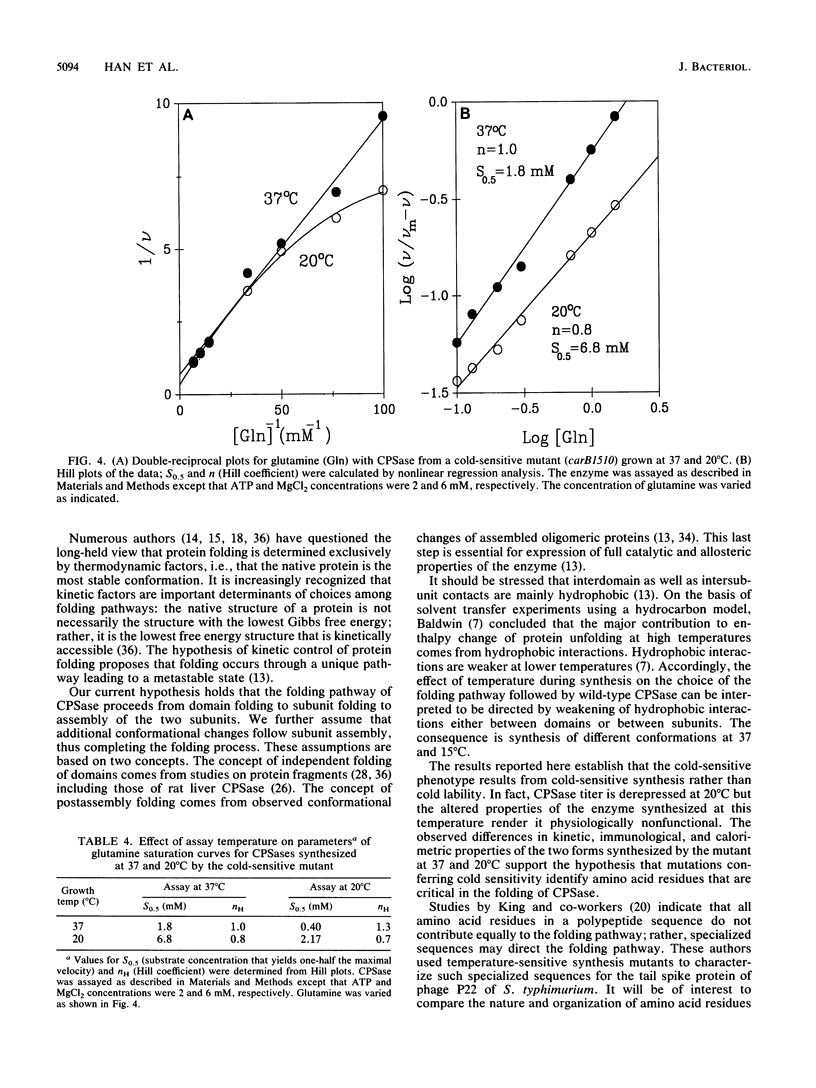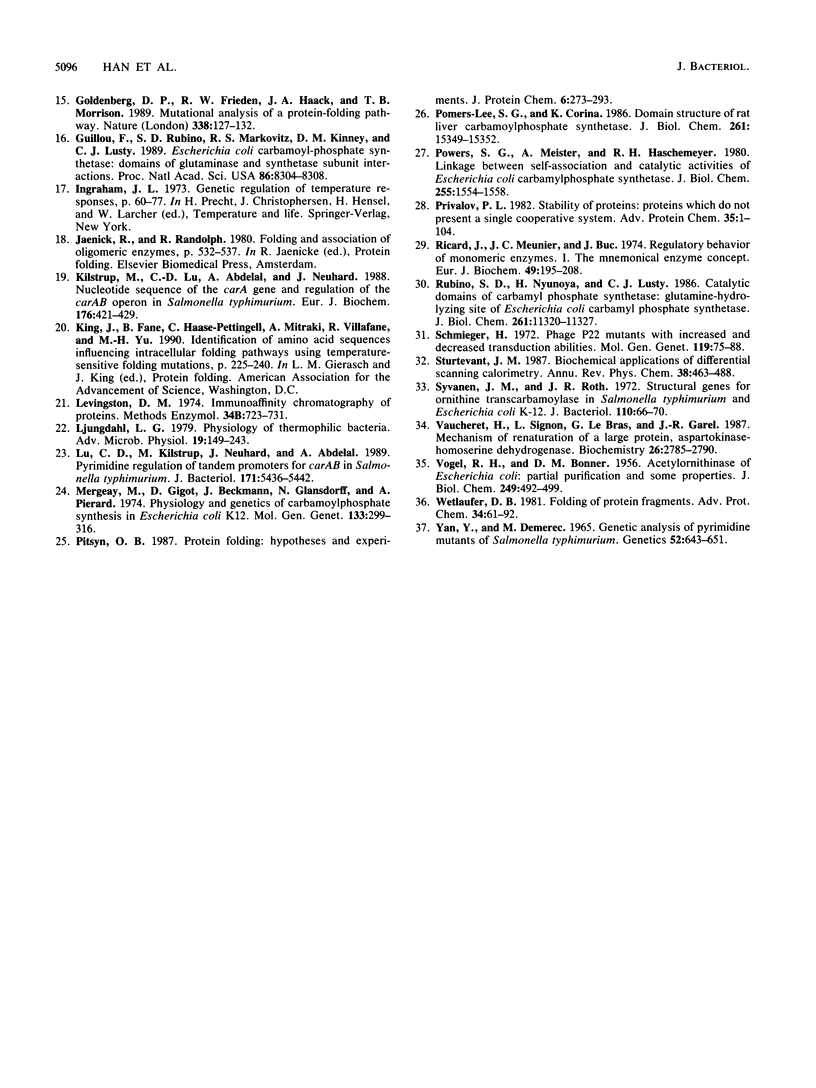Abstract
The properties of homogeneous preparations of carbamoylphosphate synthetase (CPSase) from wild-type Salmonella typhimurium and a cold-sensitive derivative grown at different growth temperatures were examined. For the cold-sensitive mutant, the affinity for glutamine of the form of CPSase synthesized at 20 degrees C was lower than that of the form of the enzyme synthesized at 37 degrees C, regardless of the assay temperature. Thus, the cold sensitivity of the mutant reflects an effect of temperature on the synthesis of the enzyme rather than the activity of the folded enzyme. The two forms also differed in sensitivities to polyclonal antibodies as well as denaturational enthalpies. The combined results support the hypothesis that carAB mutations conferring cold sensitivity identify amino acid residues that are critical in the folding of CPSase. Quite unexpectedly, certain kinetic properties of cloned parent CPSase were also dependent on the growth temperature, although to a much lesser extent than those of the cold-sensitive mutant. The specific activity of wild-type CPSase synthesized at 15 degrees C was 60% of that synthesized at 37 degrees C. Further, CPSase synthesized at 15 degrees C was less thermostable than the enzyme synthesized at 37 degrees C; the difference in stability (delta G) is estimated to be 4,500 cal mol-1. Thus, variation of temperature within the physiological range for growth influences the folding and consequently the properties of CPSase from wild-type S. typhimurium.
Full text
PDF







Selected References
These references are in PubMed. This may not be the complete list of references from this article.
- Abd-el-Al A. Arginine-auxotrophic phenotype resulting from a mutation in the pryA gene of Escherichia coli B-r. J Bacteriol. 1969 Jan;97(1):466–468. doi: 10.1128/jb.97.1.466-468.1969. [DOI] [PMC free article] [PubMed] [Google Scholar]
- Abd-el-Al A., Ingraham J. L. Control of carbamyl phosphate synthesis in Salmonella typhimurium. J Biol Chem. 1969 Aug 10;244(15):4033–4038. [PubMed] [Google Scholar]
- Abdelal A. T., Griego E., Ingraham J. L. Arginine auxotrophic phenotype of mutation in pyrA of Salmonella typhimurium: role of N-acetylornithine in the maturation of mutant carbamylphosphate synthetase. J Bacteriol. 1978 May;134(2):528–536. doi: 10.1128/jb.134.2.528-536.1978. [DOI] [PMC free article] [PubMed] [Google Scholar]
- Abdelal A. T., Ingraham J. L. Carbamylphosphate synthetase from Salmonella typhimurium. Regulations, subunit composition, and function of the subunits. J Biol Chem. 1975 Jun 25;250(12):4410–4417. [PubMed] [Google Scholar]
- Alber T., Sun D. P., Nye J. A., Muchmore D. C., Matthews B. W. Temperature-sensitive mutations of bacteriophage T4 lysozyme occur at sites with low mobility and low solvent accessibility in the folded protein. Biochemistry. 1987 Jun 30;26(13):3754–3758. doi: 10.1021/bi00387a002. [DOI] [PubMed] [Google Scholar]
- Anderson P. M. Carbamoyl-phosphate synthetase: an example of effects on enzyme properties of shifting an equilibrium between active monomer and active oligomer. Biochemistry. 1986 Sep 23;25(19):5576–5582. doi: 10.1021/bi00367a035. [DOI] [PubMed] [Google Scholar]
- Baldwin R. L. Temperature dependence of the hydrophobic interaction in protein folding. Proc Natl Acad Sci U S A. 1986 Nov;83(21):8069–8072. doi: 10.1073/pnas.83.21.8069. [DOI] [PMC free article] [PubMed] [Google Scholar]
- Bradford M. M. A rapid and sensitive method for the quantitation of microgram quantities of protein utilizing the principle of protein-dye binding. Anal Biochem. 1976 May 7;72:248–254. doi: 10.1006/abio.1976.9999. [DOI] [PubMed] [Google Scholar]
- Brandts J. F., Hu C. Q., Lin L. N., Mos M. T. A simple model for proteins with interacting domains. Applications to scanning calorimetry data. Biochemistry. 1989 Oct 17;28(21):8588–8596. doi: 10.1021/bi00447a048. [DOI] [PubMed] [Google Scholar]
- Celada F., Strom R. beta-Galactosidase: immune recognition of conformation and mechanism of antibody-induced catalytic activation. Biopolymers. 1983 Jan;22(1):465–473. doi: 10.1002/bip.360220159. [DOI] [PubMed] [Google Scholar]
- Edge V., Allewell N. M., Sturtevant J. M. High-resolution differential scanning calorimetric analysis of the subunits of Escherichia coli aspartate transcarbamoylase. Biochemistry. 1985 Oct 8;24(21):5899–5906. doi: 10.1021/bi00342a032. [DOI] [PubMed] [Google Scholar]
- Frieden C. Kinetic aspects of regulation of metabolic processes. The hysteretic enzyme concept. J Biol Chem. 1970 Nov 10;245(21):5788–5799. [PubMed] [Google Scholar]
- Goldenberg D. P., Frieden R. W., Haack J. A., Morrison T. B. Mutational analysis of a protein-folding pathway. Nature. 1989 Mar 9;338(6211):127–132. doi: 10.1038/338127a0. [DOI] [PubMed] [Google Scholar]
- Goldenberg D. P. Genetic studies of protein stability and mechanisms of folding. Annu Rev Biophys Biophys Chem. 1988;17:481–507. doi: 10.1146/annurev.bb.17.060188.002405. [DOI] [PubMed] [Google Scholar]
- Guillou F., Rubino S. D., Markovitz R. S., Kinney D. M., Lusty C. J. Escherichia coli carbamoyl-phosphate synthetase: domains of glutaminase and synthetase subunit interaction. Proc Natl Acad Sci U S A. 1989 Nov;86(21):8304–8308. doi: 10.1073/pnas.86.21.8304. [DOI] [PMC free article] [PubMed] [Google Scholar]
- Kilstrup M., Lu C. D., Abdelal A., Neuhard J. Nucleotide sequence of the carA gene and regulation of the carAB operon in Salmonella typhimurium. Eur J Biochem. 1988 Sep 15;176(2):421–429. doi: 10.1111/j.1432-1033.1988.tb14299.x. [DOI] [PubMed] [Google Scholar]
- Ljungdahl L. G. Physiology of thermophilic bacteria. Adv Microb Physiol. 1979;19:149–243. doi: 10.1016/s0065-2911(08)60199-x. [DOI] [PubMed] [Google Scholar]
- Lu C. D., Kilstrup M., Neuhard J., Abdelal A. Pyrimidine regulation of tandem promoters for carAB in Salmonella typhimurium. J Bacteriol. 1989 Oct;171(10):5436–5442. doi: 10.1128/jb.171.10.5436-5442.1989. [DOI] [PMC free article] [PubMed] [Google Scholar]
- Mergeay M., Gigot D., Beckmann J., Glansdorff N., Piérard A. Physiology and genetics of carbamoylphosphate synthesis in Escherichia coli K12. Mol Gen Genet. 1974;133(4):299–316. doi: 10.1007/BF00332706. [DOI] [PubMed] [Google Scholar]
- Powers-Lee S. G., Corina K. Domain structure of rat liver carbamoyl phosphate synthetase I. J Biol Chem. 1986 Nov 25;261(33):15349–15352. [PubMed] [Google Scholar]
- Powers S. G., Meister A., Haschemeyer R. H. Linkage between self association and catalytic activity of Escherichia coli carbamyl phosphate synthetase. J Biol Chem. 1980 Feb 25;255(4):1554–1558. [PubMed] [Google Scholar]
- Privalov P. L. Stability of proteins. Proteins which do not present a single cooperative system. Adv Protein Chem. 1982;35:1–104. [PubMed] [Google Scholar]
- Ricard J., Meunier J. C., Buc J. Regulatory behavior of monomeric enzymes. 1. The mnemonical enzyme concept. Eur J Biochem. 1974 Nov 1;49(1):195–208. doi: 10.1111/j.1432-1033.1974.tb03825.x. [DOI] [PubMed] [Google Scholar]
- Rubino S. D., Nyunoya H., Lusty C. J. Catalytic domains of carbamyl phosphate synthetase. Glutamine-hydrolyzing site of Escherichia coli carbamyl phosphate synthetase. J Biol Chem. 1986 Aug 25;261(24):11320–11327. [PubMed] [Google Scholar]
- Schmieger H. Phage P22-mutants with increased or decreased transduction abilities. Mol Gen Genet. 1972;119(1):75–88. doi: 10.1007/BF00270447. [DOI] [PubMed] [Google Scholar]
- Syvanen J. M., Roth J. R. Structural genes for ornithine transcarbamylase in Salmonella typhimurium and Escherichia coli K-12. J Bacteriol. 1972 Apr;110(1):66–70. doi: 10.1128/jb.110.1.66-70.1972. [DOI] [PMC free article] [PubMed] [Google Scholar]
- Vaucheret H., Signon L., Le Bras G., Garel J. R. Mechanism of renaturation of a large protein, aspartokinase-homoserine dehydrogenase. Biochemistry. 1987 May 19;26(10):2785–2790. doi: 10.1021/bi00384a020. [DOI] [PubMed] [Google Scholar]
- Wetlaufer D. B. Folding of protein fragments. Adv Protein Chem. 1981;34:61–92. doi: 10.1016/s0065-3233(08)60518-5. [DOI] [PubMed] [Google Scholar]
- Yan Y., Demerec M. Genetic analysis of pyrimidine mutants of Salmonella typhimurium. Genetics. 1965 Sep;52(3):643–651. doi: 10.1093/genetics/52.3.643. [DOI] [PMC free article] [PubMed] [Google Scholar]


